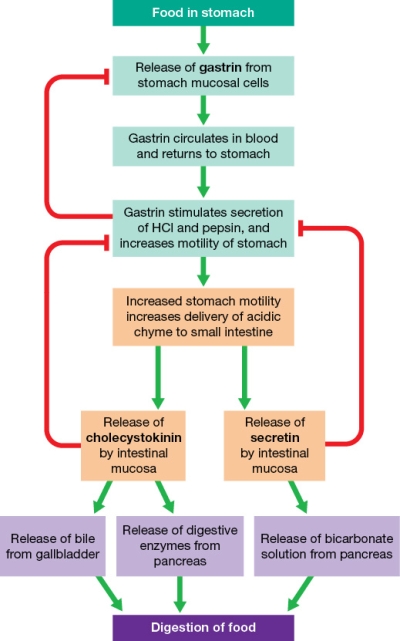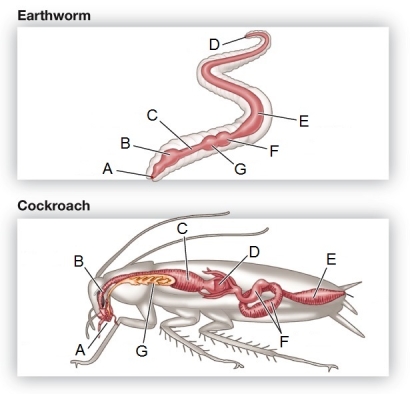A) small intestine.
B) esophagus.
C) stomach.
D) mouth.
E) large intestine.
Correct Answer

verified
Correct Answer
verified
Multiple Choice
Refer to the figure showing a mammalian tooth.  Based on the figure, which statement about mammalian teeth is true?
Based on the figure, which statement about mammalian teeth is true?
A) The crown is the part of the tooth below the gum line.
B) Dentine is present in the crown but not the root.
C) Nerves and blood vessels occur in the pulp cavity, which is the innermost layer of the tooth.
D) Cement holds the tooth in the jawbone and produces the dentine.
E) Enamel covers the crown of the tooth and consists largely of calcium carbonate.
Correct Answer

verified
C
Correct Answer
verified
Multiple Choice
Refer to the figure showing hormonal control of digestion.  Based on the figure, the production of highly acidic chyme will result in
Based on the figure, the production of highly acidic chyme will result in
A) slowing down the release of enzymes from the gallbladder.
B) speeding up the release of gastrin from the stomach cells.
C) increasing the motility of the stomach.
D) slowing down the release of bicarbonate solution from the pancreas.
E) slowing down the delivery of chyme from the stomach into the small intestine.
Correct Answer

verified
Correct Answer
verified
Multiple Choice
Which event occurs when parietal cells of the stomach create an enormous concentration difference in H+ across their plasma membranes?
A) H+ from a parietal cell is exchanged for K+ from the lumen of the gastric pit.
B) Carbonic anhydrase removes CO2 from carbonic acid.
C) K+ is pumped back into the lumen of the gastric pit.
D) Cl- is actively transported back into the bloodstream.
E) HCO3- from the blood is exchanged for Cl- from the parietal cell.
Correct Answer

verified
Correct Answer
verified
Multiple Choice
A filter feeder acquires food items by
A) restraining prey with poison.
B) restraining prey using claws and jaws.
C) ingesting mud and extracting particles.
D) filtering food substances from the blood.
E) extracting particles suspended in water.
Correct Answer

verified
Correct Answer
verified
Multiple Choice
Which organ is the main site for the interconversion of fuel molecules?
A) Stomach
B) Small intestine
C) Pancreas
D) Large intestine
E) Liver
Correct Answer

verified
Correct Answer
verified
Multiple Choice
Which statement about digestion in the small intestine is true?
A) Most digestion occurs in the stomach and most absorption occurs in the small intestine.
B) Fat in the small intestine is emulsified by bile that is produced by the gallbladder and stored in the liver.
C) Bile molecules in the small intestine have one end that is lipophobic and one end that is hydrophilic.
D) The pancreas secretes zymogens and bicarbonate ions into the duodenum of the small intestine.
E) Enterokinase is secreted by the pancreas to activate enzymes in the small intestine.
Correct Answer

verified
Correct Answer
verified
Multiple Choice
Insulin is released by the pancreas when blood levels of
A) glucose fall.
B) glucagon fall.
C) glucose rise.
D) glucagon rise.
E) secretin fall.
Correct Answer

verified
Correct Answer
verified
Multiple Choice
The major function of the colon, or large intestine, is the
A) digestive breakdown of foods.
B) absorption of nutrients from foods.
C) housing of parasitic bacteria.
D) secretion of bile and enzymes.
E) reabsorption of ions and water.
Correct Answer

verified
Correct Answer
verified
Multiple Choice
A woman who has heavy menstrual bleeding each month goes to the doctor because of persistent fatigue.Her doctor explains she is suffering from a deficiency in a micronutrient.The doctor is most likely to prescribe a(n)
A) vitamin C supplement, or eating lots of citrus fruit.
B) folic acid supplement, or drinking lots of tea.
C) iron supplement, or eating lots of liver or red meat.
D) zinc supplement, or decreasing her salt intake.
E) vitamin E supplement, or decreasing her fat intake.
Correct Answer

verified
Correct Answer
verified
Multiple Choice
Which statement about the tubular digestive tract of animals is true?
A) Food is digested primarily intracellularly.
B) There is one opening to the digestive tract.
C) Food must always be broken into smaller pieces before ingestion.
D) All digestion occurs inside the digestive tract.
E) The digestive tract is uniform throughout its length.
Correct Answer

verified
Correct Answer
verified
Multiple Choice
The hormone secretin is a chemical message
A) secreted by the pancreas.
B) secreted by the stomach.
C) whose release is stimulated by the nervous system.
D) that triggers the intestine to release enzymes.
E) that triggers pancreatic secretion of a bicarbonate-rich solution.
Correct Answer

verified
Correct Answer
verified
Multiple Choice
The hormone cholecystokinin (CCK) , released by the _______, stimulates contractions of the _______, ultimately leading to squirts of _______ entering the lumen of the small intestine.
A) stomach; gallbladder; trypsin
B) small intestine; liver; bile
C) small intestine; gallbladder; bile
D) liver; gallbladder; zymogen
E) gallbladder; liver; bile
Correct Answer

verified
C
Correct Answer
verified
Multiple Choice
Of the food components listed, which provides the least amount of metabolic energy for animals?
A) Carbohydrates
B) Nucleic acids
C) Proteins
D) Fats
E) Sugars
Correct Answer

verified
Correct Answer
verified
Multiple Choice
Which statement about gastrovascular cavities is true?
A) They are found in earthworms but not in cnidarians.
B) Enzymes in these cavities partially digest prey.
C) They have a mouth at one end and an anus at the other.
D) Extracellular digestion completes the breakdown of food particles.
E) They are found in sponges.
Correct Answer

verified
B
Correct Answer
verified
Multiple Choice
Which layer of the vertebrate gut shows adaptations for increasing absorptive surface area?
A) Lumen
B) Mucosa
C) Submucosa
D) Serosa
E) Peritoneum
Correct Answer

verified
Correct Answer
verified
Multiple Choice
Which statement about vitamin C is true?
A) All mammals, but not other vertebrates, must obtain it in their diet.
B) It is fat-soluble.
C) When not obtained in the human diet, scurvy results.
D) It is an oxidant.
E) Rice is a good source of vitamin C.
Correct Answer

verified
Correct Answer
verified
Multiple Choice
Refer to the figure showing the digestive systems of an earthworm and a cockroach.  Identify the structure in each organism used for grinding food.
Identify the structure in each organism used for grinding food.
A) A in earthworm and A in cockroach
B) C in earthworm and B in cockroach
C) G in earthworm and C in cockroach
D) E in earthworm and F in cockroach
E) F in earthworm and D in cockroach
Correct Answer

verified
Correct Answer
verified
Multiple Choice
The surface area of the intestines is increased in humans by the _______, in sharks by the _______, and in earthworms by the _______.
A) villi and microvilli; spiral valve; typhlosole
B) villi and microvilli; typhlosole; spiral valve
C) villi and microvilli; length of the intestine; spiral valve
D) villi and lacteals; spiral valve; typhlosole
E) caecum; length of the intestine; villi and microvilli
Correct Answer

verified
Correct Answer
verified
Multiple Choice
Researchers recently reported that the green sea slug, Elysia chlorotica, can incorporate genes from algae, allowing them to use solar energy to meet their energy needs.Sea slugs can therefore be described as
A) predators.
B) heterotrophs.
C) carnivores.
D) herbivores.
E) autotrophs.
Correct Answer

verified
Correct Answer
verified
Showing 1 - 20 of 259
Related Exams